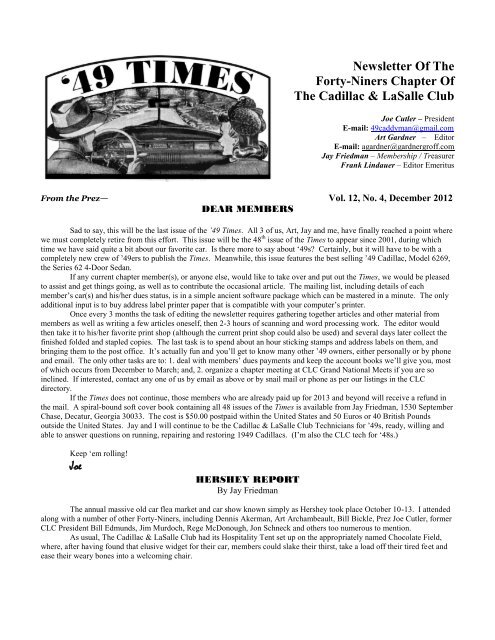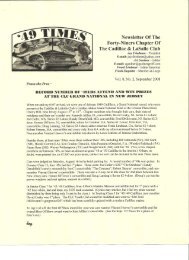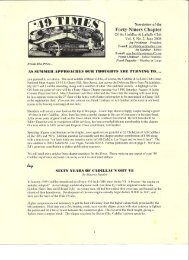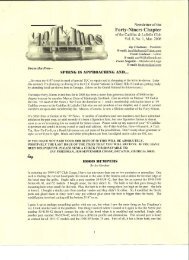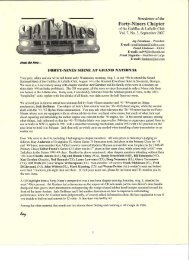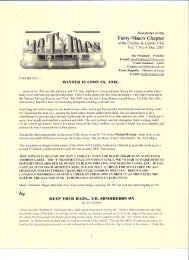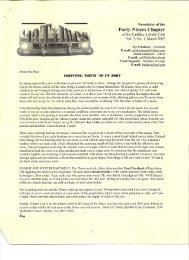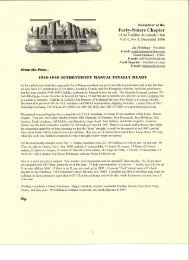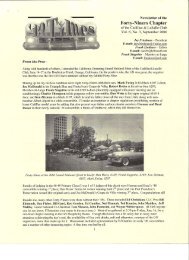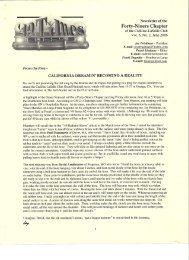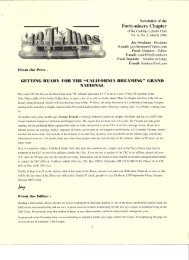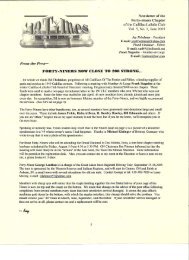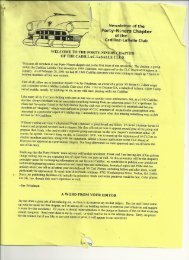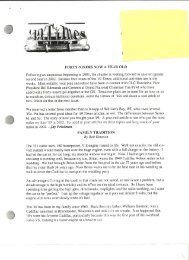Create successful ePaper yourself
Turn your PDF publications into a flip-book with our unique Google optimized e-Paper software.
Newsletter Of The<br />
Forty-Niners Chapter Of<br />
The Cadillac & LaSalle Club<br />
Joe Cutler – President<br />
E-mail: 49caddyman@gmail.com<br />
Art Gardner – Editor<br />
E-mail: agardner@gardnergroff.com<br />
Jay Friedman – Membership / Treasurer<br />
Frank Lindauer – Editor Emeritus<br />
From the Prez— Vol. 12, No. 4, <strong>December</strong> <strong>2012</strong><br />
DEAR MEMBERS<br />
Sad to say, this will be the last issue of the ’49 Times. All 3 of us, Art, Jay and me, have finally reached a point where<br />
we must completely retire from this effort. This issue will be the 48 th issue of the Times to appear since 2001, during which<br />
time we have said quite a bit about our favorite car. Is there more to say about „49s? Certainly, but it will have to be with a<br />
completely new crew of ‟49ers to publish the Times. Meanwhile, this issue features the best selling ‟49 Cadillac, Model 6269,<br />
the Series 62 4-Door Sedan.<br />
If any current chapter member(s), or anyone else, would like to take over and put out the Times, we would be pleased<br />
to assist and get things going, as well as to contribute the occasional article. The mailing list, including details of each<br />
member‟s car(s) and his/her dues status, is in a simple ancient software package which can be mastered in a minute. The only<br />
additional input is to buy address label printer paper that is compatible with your computer‟s printer.<br />
Once every 3 months the task of editing the newsletter requires gathering together articles and other material from<br />
members as well as writing a few articles oneself, then 2-3 hours of scanning and word processing work. The editor would<br />
then take it to his/her favorite print shop (although the current print shop could also be used) and several days later collect the<br />
finished folded and stapled copies. The last task is to spend about an hour sticking stamps and address labels on them, and<br />
bringing them to the post office. It‟s actually fun and you‟ll get to know many other ‟49 owners, either personally or by phone<br />
and email. The only other tasks are to: 1. deal with members‟ dues payments and keep the account books we‟ll give you, most<br />
of which occurs from <strong>December</strong> to March; and, 2. organize a chapter meeting at CLC Grand National Meets if you are so<br />
inclined. If interested, contact any one of us by email as above or by snail mail or phone as per our listings in the CLC<br />
directory.<br />
If the Times does not continue, those members who are already paid up for 2013 and beyond will receive a refund in<br />
the mail. A spiral-bound soft cover book containing all 48 issues of the Times is available from Jay Friedman, 1530 September<br />
Chase, Decatur, Georgia 30033. The cost is $50.00 postpaid within the United States and 50 Euros or 40 British Pounds<br />
outside the United States. Jay and I will continue to be the Cadillac & LaSalle Club Technicians for ‟49s, ready, willing and<br />
able to answer questions on running, repairing and restoring 1949 Cadillacs. (I‟m also the CLC tech for „48s.)<br />
Keep „em rolling!<br />
Joe<br />
HERSHEY REPORT<br />
By Jay Friedman<br />
The annual massive old car flea market and car show known simply as Hershey took place October 10-13. I attended<br />
along with a number of other Forty-Niners, including Dennis Akerman, Art Archambeault, Bill Bickle, Prez Joe Cutler, former<br />
CLC President Bill Edmunds, Jim Murdoch, Rege McDonough, Jon Schneck and others too numerous to mention.<br />
As usual, The Cadillac & LaSalle Club had its Hospitality Tent set up on the appropriately named Chocolate Field,<br />
where, after having found that elusive widget for their car, members could slake their thirst, take a load off their tired feet and<br />
ease their weary bones into a welcoming chair.
Displayed in front of the tent as an attraction to passers-by was Art Archambeault‟s gorgeous Cypress Green Series 62<br />
Sedan. No doubt it was there to tempt non-CLC members to enter the tent and join the club, as well as to serve as a landmark<br />
to let members know they had come to the right place. In any case, Art‟s 6269 couldn‟t be missed.<br />
ART ARCHAMBEAULT’S 6269<br />
PARKED IN FRONT OF THE CLC HOSPITALITY TENT AT HERSHEY OCTOBER 11 th<br />
ENGINE PAINT INFO FROM THE CADILL-IKES, THE CLC 1954-56 CHAPTER<br />
Here is the formula number for Cadillac engine dark blue according to paint manufacturers:<br />
BASF aka R-M: Formula Number 243212. BASF carries this color in 22 varieties of paint. Everything from base coat<br />
to single stage and high end to low end paint.<br />
Dupont: Formula Number BS454. Dupont has a cross over formula that is available in their most popular varieties.<br />
The color swatch has been checked and looks correct<br />
It is recommended that the BASF formula be used. R-M (BASF) was a main paint supplier to Cadillac when engines were<br />
painted dark blue and it looks like R-M has maintained this color formula until the present time.<br />
STOP! PLEASE DON’T CHOP THAT CADILLAC<br />
(OR, ARE YOUR DESIGN SKILLS REALLY BETTER THAN HARLEY EARL’S?)<br />
By Art Gardner<br />
I have had ten 1949-56 Cadillac‟s over the last 25 years. Some I kept bone stock, one I highly modified, and to<br />
several I made minor “tweaks” to improve performance/reliability/safety/convenience. From my experience, I encourage you<br />
to consider keeping your ‟49 or any other old Cadillac completely stock or very stock -- for financial, aesthetic, and enjoyment<br />
reasons. Don‟t do something you will regret later, as there are many hidden dangers and pitfalls in modifying old Cadillac‟s.
To me, the biggest drawback is that most people are not as skilled at car design as the original designers (no surprise<br />
there) and the car is likely to end up looking and performing much worse than the original. Secondly, it is often a financial<br />
disaster to make big changes to a ‟49 or other old Cadillac. Many people start down a path of "customizing" a classic car by<br />
chopping the top, frenching the headlights, shaving the door handles and other exterior chrome, adding louvers, replacing the<br />
engine with a generic Chevy 350, etc. Most of the time this ends up ruining the car permanently. Do you really think you can<br />
make a classic Cadillac more beautiful than did the original designers? Perhaps, but most such modifications rob the car of its<br />
intrinsic appeal and make it uglier, not prettier. Sometimes the car does end up looking good. But often not.<br />
I strongly recommend retaining the original drive train, as the 331 Cadillac engine is very, very good – in fact it was at<br />
the top of the heap for decades and is just as mechanically reliable as any small block Chevy. Same thing for the our<br />
HydraMatic transmission. It is just about bullet-proof. If yours doesn‟t work like it should or if it leaks, get it professionally<br />
rebuilt and enjoy years of trouble-free automatic shifting.<br />
Without going into all of the gory details, here are my bottom-line recommendations, learned the hard way, for what<br />
works well on a 1949 Cadillac:<br />
1. If it came with 6 volts, keep it 6 volts if possible. Pay attention to grounds and the proper cables. Six volts works!<br />
2. If you must improve the electrics, use a 6 volt alternator (keeping the voltage regulator in place for looks).<br />
3. On a ‟49, just a “sample” of the current goes through the ammeter, so keep the ammeter as is.<br />
4. Use a better battery (I like the 6v Optima a lot).<br />
5. Add air conditioning if you have to in order to use the car (in which case you would have to convert the car to 12<br />
volts). Otherwise, don‟t.<br />
6. Use stainless steel brake lines (to resist internal corrosion) and dual circuit master cylinders for redundant safety. If<br />
sticking with a single circuit master, have it sleeved with brass or stainless steel to stop internal corrosion. If you can<br />
afford it, have the wheel cylinders sleeved with brass or stainless steel also. Use a remote brake reservoir (you can use<br />
parts from a ‟54 and later Cadillac) to allow you to check the fluid regularly.<br />
7. Convert your non-functioning clock to a quartz movement.<br />
8. Use an electronic ignition module (e.g., Pertronix) or a dual point distributor plate for better ignition.<br />
9. Keep the exhaust stock, but increase the pipe size slightly to a 2¼ inches diameter for better breathing.<br />
10. Keep the fuel system stock. If vapor lock or engine overheating is a problem, use an electric fuel pump for “go” and<br />
keep the mechanical pump just for “show” (remove the rod and route the fuel through the non-working mechanical<br />
pump).<br />
11. Avoid adding power steering; but if you must, use a later Cadillac system. Avoid rack and pinion.<br />
12. Use radial tires. If your car doesn‟t have power steering, look for radials with a very narrow contact patch (e.g., the<br />
Diamondback 700R15) and run the recommended higher inflation air pressure.<br />
13. Keep your stock radio, but have it rebuilt. Rebuilders can add an MP3 input to the radio to play FM and digital music<br />
files.<br />
14. Add seat belts, which can be easily done. On 4-door sedans and Series 75 limos, you should add shoulder belts.<br />
15. Install a thicker stabilizer bar up front (like the‟49 limos and hearses have) – you will be glad you did and no one will<br />
know.<br />
16. Stick with the vacuum wipers if you can. If not, enjoy your electric wipers!<br />
If you follow this advice, you will love using your car and will find that you drive it more and more. Above all, my<br />
cardinal rule is that if you feel compelled to change something, please change it in a way that can be undone easily (keep the<br />
original parts if you can and make the change a bolt-on operation). In other words, make the change a reversible one! Also, if<br />
possible, try to make the change look like it came that way from the factory. For example, if you are replacing the generator<br />
with an alternator, don‟t use a chrome-plated alternator that will look terribly out of place in a 1949 Cadillac engine bay.<br />
Instead, get one that is black or paint it black to fit in with the rest of the engine bay.<br />
In the end, it is your car, not mine, so do what makes you happy. But if you do want to tweak your car some, you will<br />
be miles ahead if you learn from my mistakes and triumphs. If you have specific questions about any of this, feel free to<br />
contact me at agardner@gardnergroff.com.<br />
CHANGING YOUR DIFFERENTIAL PINION SEAL<br />
By Jay Friedman<br />
The first thing, of course, is to buy a new seal. A good source is Olcar Bearings and Seals, Southern Pines NC, 910-<br />
693-3324 (no web site or email). USA Parts Supply and others sell it too. There are 2 types of pinion seals on 1941-56
Cadillacs, which are unrelated to year or model; some are one type, some are the other. If I remember, the difference is that<br />
one has a narrower outside diameter than the other because it is in a "cup" of some kind. Call Olcar for details. To save time, I<br />
bought one of each type and returned the one I didn't use because I couldn't figure out which one I had before removing the old<br />
one.<br />
To take the old one out you have to get the rear of the car well up in the air. It can be done on the ground with jack<br />
stands, but it is best over a pit or on a lift. You'll need a large socket wrench, breaker bar and torque wrench, probably 3/4"<br />
drive, to turn the pinion seal nut. You also need a large pipe wrench or large monkey wrench or some other tool to hold the<br />
driveshaft yoke from turning while you turn the nut. With another guy tightly gripping the wrench on the yoke--or you can<br />
brace the end of the pipe/monkey wrench against the floor or frame of the car--you remove the nut and then the yoke, and<br />
either pry out the seal or use a seal remover to get it out. You drive in the new seal with a large socket and tap the yoke back<br />
on.<br />
Now comes the hard and tricky part. You must "pre-load" the bearing behind the seal. To do this you torque the nut<br />
to a very high torque rating as per the shop manual. You then measure the load on the bearing by rotating the pinion shaft<br />
using the socket and breaker bar, and measure the pounds of "pull" you need on a small spring scale as per the shop manual.<br />
You may have to undo the nut and re-torque it to get it right.<br />
Since you have to get the back of the car reasonably high off the ground, need heavy tools, must get the pre-load right<br />
and probably a 2nd guy to help, it may be best to have this job done by a professional. I've done it three times over the years<br />
on 3 different '49 Cadillacs, including my own. However, each time I was helping friends more skilled than myself who had<br />
the right tools and knowledge. The first time was on the ground, the second time was using a pit and the 3rd time was on a<br />
lift. The 2nd and 3rd times were, of course, a lot easier.<br />
RANDY DENCHFIELD IN CHEVY CHASE, MARYLAND WITH HIS 40,000 MILE 6269<br />
FORTY-NINE 4-DOOR SEDANS IN THE FIFTIES<br />
By Jay Friedman<br />
More than one Forty Niner has some historical family connection to a ‟49 Cadillac. Prez Joe Cutler‟s Dad bought a<br />
Series 62 Club Coupe way back when, which Joe says was the inspiration for his own case of ‟49-itis today. „49er Curtis<br />
Smith of Littleton, Colorado‟s grandfather bought a Series 61 4-door in 1953 that Curt still owns. And there are other chapter<br />
members who have similar stories about various ‟49 models.<br />
Nonetheless, the best selling ‟49 Cadillac was the Series 62 4-door sedan. 37,617 of the 6269s were made,<br />
constituting 40% of all „49s manufactured, more than twice as many as the next best selling model, the nearly identical Series<br />
61 sedan (of which only 15,738 were made). Not surprisingly, more than one Forty-Niner has a family story about a long-ago-
owned 6269. The first is from Alan Towne of Ocean Park, Washington whose grandmother owned a gray Series 62 sedan. It<br />
is shown in the photo below, which was taken in 1950 at Seaside, Oregon.<br />
My Dad also owned a Series 62 4-door. He bought it second-hand in 1951, trading in a green 1948 Oldsmobile 98<br />
convertible. (Wish I had that Olds now!). Our 6269 was also gray, identical to Alan‟s grandmother‟s car, and is shown below.<br />
In the photo, taken on a 1952 vacation trip to the Catskill Mountains of upstate New York, my Dad is seated between<br />
my brother and me. We kids thought it was great that our family car was now a prestigious Cadillac, even though it was 2years<br />
old.<br />
Unfortunately, not long after the picture was taken, our family „49 came to an untimely end. We lived in New York<br />
City and one day my father parked it on a steep hill in the Bronx. I don't know what he failed to do--either the Hydramatic<br />
wasn‟t in “R” or the hand brake wasn't set, or both--but after he locked the doors it rolled down the hill and self-destructed<br />
against some immoveable object. Fortunately, no people were around and there was no other damage. Following that episode<br />
my Dad stuck with Oldsmobiles.
SERIES 62 SEDAN BELONGING TO DOMINIQUE HERMENAULT, BORRÈZE, FRANCE<br />
No doubt Dominique‟s 6269 will be as nice as Art Archambeault‟s or Randy Denchfield‟s one day, since Dominique<br />
writes that he is going to restore the car “down to the last bolt”, which he estimates will take about 5 years. It was vandalized<br />
at some point but is complete except for the glass, the goddess, the V and the hood crest. It is hard to tell but the wheels seem<br />
to indicate that its original color was Triumph Blue Metallic.<br />
IN RESPONSE TO SEVERAL MEMBERS RECENTLY ASKING WHETHER IT CAN BE DONE, ART GARDNER<br />
DEMONSTRATES HOW TO REMOVE THE UPPER HALF OF A ROPE-TYPE REAR MAIN BEARING SEAL<br />
WITH THE ENGINE IN THE CAR AS PER HIS ARTICLE IN THE DECEMBER 2008 TIMES.<br />
YOU MUST REMOVE THE OIL PAN AND REAR MAIN BEARING CAP AND SCREW A WOOD OR SHEET<br />
METAL SCREW INTO ONE SIDE OF THE SEAL. PULL ON THE SCREW WITH A PAIR OF PLIERS WHILE<br />
PUSHING AGAINST THE OTHER SIDE OF THE SEAL WITH A SOFT PUNCH AND OUT IT WILL COME.
AN ENTIRE DASH IN THE PROCESS OF BEING REMOVED FROM A ‘49<br />
(Dash shown is in The Empress, a low-mileage sedan Prez Joe recently bought in Colorado)<br />
In the photo, the following has been done so far: 1. The vent control knob and bracket have been unfastened from the<br />
dash; 2. The hand brake handle bracket has been unbolted; 3. The windshield wiper-washer switch and the fog light switch<br />
have been removed; 4. The instrument panel has been removed, with a piece of cloth protecting the steering column from<br />
being scratched by the instrument panel as it is withdrawn from the dash; 5. The molding has been removed from the bottom<br />
of the windshield and the top of dash to expose the screws holding the dash to the cowl.<br />
The following is still to be done: 1. The radio must be removed; 2. The steering column bracket holding the steering<br />
column to the dash must be removed. 3. The head light switch must be removed. 4. The wiring harness must be disconnected.<br />
(Note the Allen wrench in the nut holding the head light switch to the dash after the switch knob has been removed).<br />
AND OFF IT COMES, A PIECE OF CAKE!
‟49 Times<br />
Art Gardner<br />
650 Gunby Road<br />
Marietta, GA 30067


